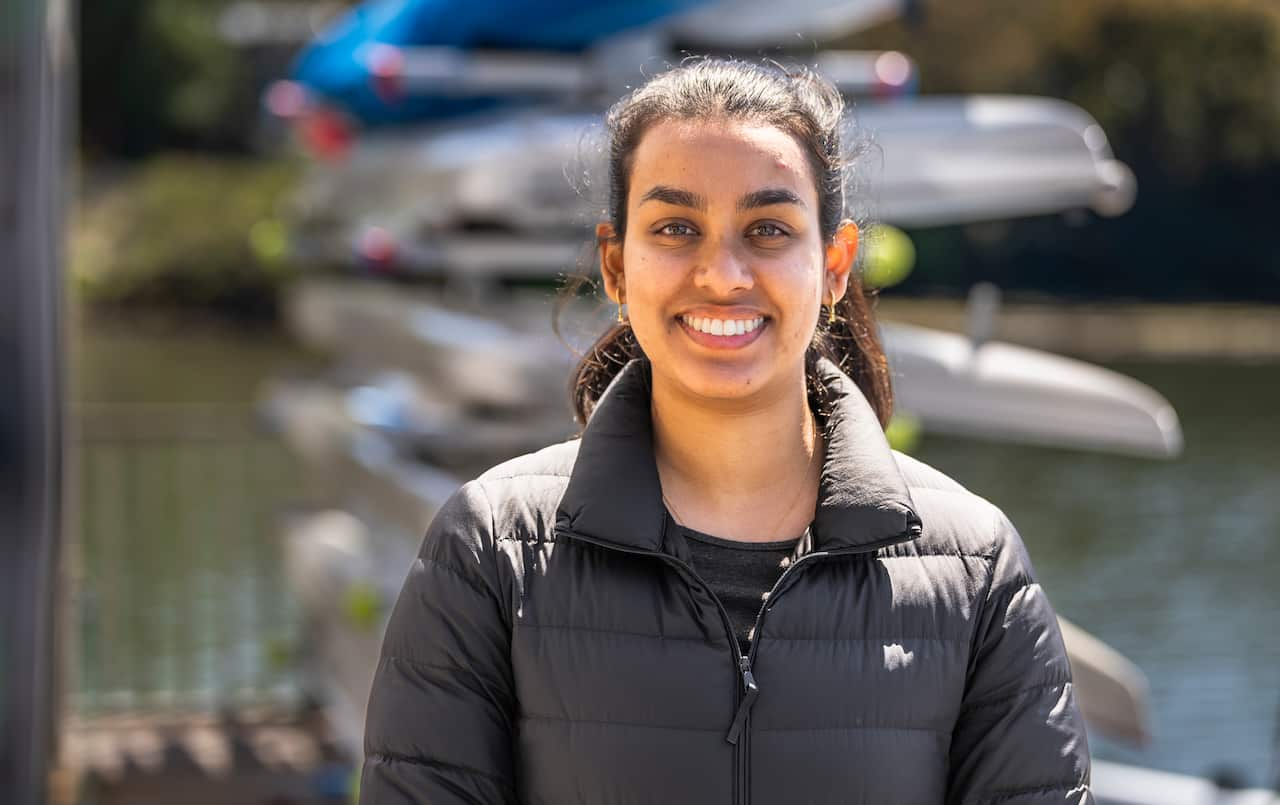It's Saturday morning, and the sun is rising over Sydney Harbour.
For Matilda, it's time for rowing training.
"I love the rowing community," she said. "It's a very social sport and something that really tests your power and your ability."
The 24-year-old Dharug woman has been rowing since she was 14.
But she has faced challenges.
Matilda was born with two fingers on her left hand. So, she has only ever been able to row "sweep" — using one oar. This means she can't row in a single scull.
"That is something I've really wanted to do, my whole rowing career. To be able to row by myself in a scull boat with two oars."
Now she can.

Matilda rows in a team of eight at the Community Rowing Club on Sydney Harbour. Source: SBS / Spencer Austad
The designers say it has the potential to help Matilda and many other rowers.

Shevaani Rams, Fiona Chen, and Biruthivi Babu (left to right) studied engineering at the University of New South Wales. Source: SBS / Spencer Austad
Innovative solutions to unusual challenges
Shevaani Rams, 24, who is a junior biomedical engineer and lead designer on the project, said: "We wanted Matilda to be able to row in a scull rowing boat, which means rowing with both oars."
The device consists of two parts. One is a prosthetic that fits onto Matilda's left arm and attaches to the oar, while the other is a mechanism fixed to the rigger that rotates the oar.
"During each stroke, the oar needs to rotate 90 degrees," Rams said.
"The blade needs to go from being flat on the water to being perpendicular to the water — what rowers call 'feather to stroke'."
To achieve this, the students attached two pieces of metal strings to either side of the oar that would rotate the oar in the right direction at the end of each stroke.

An oar rotation device attached to the rigger allows Matilda to row with both hands. Source: SBS / Spencer Austad
"We had to find a way to connect the oar to the prosthetic but still let the oar rotate," Rams said.
To solve this, they used a 3D-printed shell consisting of two concentric cylinders made from a carbon fibre-nylon blend.
"The inner cylinder rotates with the oar, while the outer cylinder stays stationary relative to the oar."
The prosthetic was crafted from lightweight carbon fibre, while the oar rotation device was made from marine-grade stainless steel that is both waterproof and durable.
"Needing to use stainless steel posed an interesting challenge," Rams said. "But we strategically cut holes in the stainless steel to make it lighter."

Shevaani Rams led an all-female team of engineering students in designing assistive technology. Source: SBS / Spencer Austad
"It's been amazing to have the engineers come down to the water," Matilda said.
"They were able to see me, see the way that my body works, see the way a rowing boat works in the sport.
"How tall you are, the way you sit in a boat is all so personal."

Matilda can now row with two oars, thanks to the device designed by engineering students. Source: SBS / Spencer Austad
Technology that makes a difference
Matilda is a member of the para-rowing program at the Community Rowing Club on Sydney's north shore.
Engineering students from AT Hub have also developed other innovative devices for members of the club, such as a footplate designed for rowers with a leg prosthetic and a device to assist a man with limited hand movement due to cerebral palsy.
Another student team is working on a customised seat for a rower who was born without a left leg and uses crutches to walk.
Community Rowing Club president Barbara Ramjan said: "The [customised] seat is built up on that side and takes into consideration the contours of his body."

Barbara Ramjan is the president of the Community Rowing Club in Sydney. Source: SBS / Spencer Austad
Matilda said her new device will allow her to compete in a range of boat classes.
"I'm able to compete in a whole different category, a whole new level of sport, which is really exciting."

Emma Su and Shevaani Rams check the oar rotation device. Source: SBS / Spencer Austad
Individual solutions for individual needs
Designers say the technology has global potential.
Associate professor Lauren Kark, academic lead of AT Hub, said: "What they have developed can be applied to anyone who may need assistance in turning an oar."

Associate professor Lauren Kark from Assistive Tech Hub says there is still room for improvement in the development of assistive technology. Source: SBS / Spencer Austad
Assistive technology includes any product that enhances learning, working or daily living for people with disability.
It covers wheelchairs, prosthetic limbs and digital solutions such as captioning or educational software. It can also be something simple like a communication board made from felt fabric.
Of more than 5 million Australians living with disability, more than 2.3 million use assistive technology, according to the Australian Bureau of Statistics.
Kark said there is room for improvement.
"I think we can definitely do better. People can access a range of assistive technologies, but particularly the bespoke assistive technology is harder," she said.
"Often it's because of the cost, but often it's access to personnel. And so that's where our students come in to fill that gap."
Ramjan said the new technology will enable rowers of all abilities to participate fully.
"It's brought so much joy to our rowers. It's allowed them to feel like anyone else to get in a boat and to do what they haven't been able to do," she said.
"For a moment, it has taken away disability and allowed them to feel what it's like to row without impairment."
Matilda agrees.
"I think something like this is going to be amazing because rowers after me can just use the exact same thing."












